A debate is forming about the U.S. response to COVID-19 and it’s worthwhile to consider this debate early, as it develops, before battle lines harden.
On one side is the school of thought that shutdowns, lockdowns and closing of “nonessential” businesses were an overreaction to either inaccurate or exaggerated computer models on the spread of the new coronavirus. And the resulting impact on our economy is as bad, or worse, than the relative loss of life that would have occurred had less draconian measures been taken.
An offshoot of this argument is that even if the models were accurate, the government reaction should have taken a drastically different form: Instead of lockdowns, we should have focused on protecting our most vulnerable while allowing “herd immunity” to grow in the younger population.
>>> When can America reopen? The National Coronavirus Recovery Commission, a project of The Heritage Foundation, is gathering America’s top thinkers together to figure that out. Learn more here.
On the other side is the argument that the measures taken by government at all levels were a rational, prudent response to warnings from multiple credible public health experts that without mitigation, up to 2 million Americans could die from COVID-19.
Hampering our assessment of both arguments is the relative lack of information about the true nature of the SARS-CoV-2 virus that causes the disease.
We still, for example, do not fully understand its reproduction rate (R0), its case fatality and hospitalization rates with all variations for age and co-morbidities, the immunity conferred by infection, or relative penetration of the virus into the American population. Nor do we know whether there will be multiple waves of the virus, or just this one.
Every hour another news story gives more credence to one side of the argument or the other. So here comes one that says the new coronavirus is more lethal that we initially believed. Now, here is another that says that a much greater percentage of Americans may already have been infected and recovered.
Well-meaning individuals forward these links to their friends and colleagues, and say “See?” And friends respond with, “Yes, OK, but have you seen this?”
How many times have you heard comparisons of the coronavirus to the flu? “It’s worse.” “No, it’s not.”
So, we are being buffeted hourly by multiple conflicting pieces of information. It’s exhausting to keep up.
In essence, we are being asked to make summary judgments about a story that is still developing. And that has its pitfalls. We should know a lot more in four to five months, but right now we are still in the eye of the hurricane with a great deal of uncertainty about how this comes out.
We know a few things, however.
COVID-19 is not some hypothetical threat. Many might still remember the “Y2K bug” scare. For those who don’t, the Y2K bug was the widely publicized danger that as the century turned over from 1999 to 2000 all the computerized systems we depend on to run our society would stop working due to some fatal flaw in their programming.
It never materialized.
This is not that. The scenes from Bergamo, Italy and Manhattan are stark evidence that when the virus runs unchecked through a city, it kills in large numbers and in a way that overwhelms our normal medical facilities, causing chaos and tragedy.
We also know that the economic devastation being wrought by COVID-19 is on an almost inconceivable scale. This was brought home Tuesday when oil hit minus $37 a barrel.
Millions are out of work and suffering for it. Hosts of businesses declaring bankruptcy is now a daily occurrence.
Leaders know that they live in a fishbowl when it comes to the decisions they make. Underreact to a threat and leaders are accused of placing American lives in undue danger. Overreact and they will be blamed for overreach and destroying the economy.
Monday morning quarterbacking is a professional sport in America, and leaders make decisions knowing they will be judged.
Americans are gaining a healthy skepticism of computer models and graphs. Family dinners now include discussions of the merits of the IHME versus Imperial College London’s epidemic models.
Many Americans already have familiarity with weather models, the ones that say, for example, there is a 40% chance that Hurricane Roxanne will hit Charleston.
But it’s new ground when our own human behavior changes a model. So when social distancing is practiced, for example, how it can drive the infection curve down. That’s the equivalent of saying that if the people in Charleston put plywood over their windows, the hurricane will go elsewhere.
Much will be written on both sides of this issue. Some of it will be informed and useful. But more time probably is necessary to establish a true perspective.
When seeking to judge a leader’s actions, I find it useful to consider the circumstances of their decisions. Put yourself in a governor’s place in mid-March and consider the limited information available at the time–not now, with the clarity of hindsight. This exercise can provide a dimension of humility to the discussion.
In the meantime, it might be best to wait before making an ultimate judgment.
This piece originally appeared in The Daily Signal



